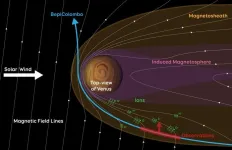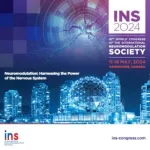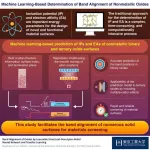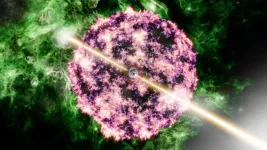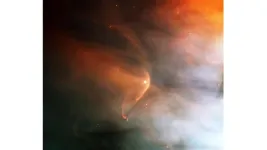(Press-News.org) In cellular biology, unraveling the complexities of cellular function at the molecular level remains a paramount endeavor. Significant scientific focus has been placed on understanding the interactions at organelle contact sites, especially between mitochondria and the endoplasmic reticulum (ER). These sites are critical hubs for the exchange of essential biomolecules, such as lipids and calcium, which are vital for maintaining cellular homeostasis. Disruptions in this inter-organelle communication are implicated in the onset of various diseases, including neurodegenerative disorders, emphasizing the need to elucidate the mechanisms governing organelle interactions. However, the study of these dynamic complexes presents significant challenges due to the lack of available tools, complicating the quest to understand ER-mitochondria contact sites.
Emerging from this need, a novel strategy called “OrthoID” has been developed through the collaborative efforts of scientists from POSTECH, Daegu Catholic University School of Medicine, and Seoul National University. Featured in Nature Communications, OrthoID addresses this challenge by refining our ability to identify proteins that act as mediators in these critical conversations.
Traditional methods relied heavily on the streptavidin-biotin (SA-BT) binding pair system, derived from nature, for tagging and isolating these mediator proteins. However, this approach has its limitations, particularly in capturing the full spectrum of protein interactions between two different organelles. OrthoID overcomes these limitations by introducing an additional synthetic binding pair, cucurbit[7]uril-adamantane (CB[7]-Ad), to work alongside SA-BT. The combination of mutually orthogonal binding pair systems allowed a more precise identification and analysis of the mediator proteins that freely translocate between the ER and mitochondria, facilitating a deeper exploration of the proteins involved in the organelle contact sites and uncovering their roles in cellular functions and disease mechanisms.
Through meticulous experiments, the researchers have demonstrated the efficacy of OrthoID in rapidly and accurately labeling proteins involved in the dynamic processes of organelle communication. By leveraging proximity labeling techniques (APEX2 and TurboID) with orthogonal binding pair systems, the method effectively labeled and isolated proteins facilitating the critical interactions between mitochondria and ER. This approach not only identifies known proteins involved in ER-mitochondria contacts but also uncovers new protein candidates, including LRC59, whose roles at the contact site were previously unknown. Moreover, they also successfully pinpointed the multiple protein sets undergoing structural and locational changes at the ER-mitochondria junction during critical cellular process such as mitophagy, where damaged mitochondria are targeted for degradation.
“The flexibility and modularity of OrthoID are among its greates strengths.” states Prof. Kimoon Kim who led the research from POSTECH. This adaptability not only allows for the study of various organelle contact sites but also opens new avenues for exploring complex cellular communications, overcoming the technical limitations of existing methods."
Prof. Kyeng Min Park from Daegu Catholic University School of Medicine adds, “OrthoID stands as a versatile and useful research tool, aimed to decode the complex language of cellular communication. It is expected to facilitate discoveries that will have profound implications for understanding cellular health, elucidating disease mechanisms, and fostering the development of new therapeutic strategies.”
The collaborative team included Prof. Kimoon Kim and Dr. Ara Lee from the Department of Chemistry, Dr. Gihyun Sung from the Division of Advanced Materials Science at Pohang University of Science and Technology (POSTECH), Prof. Kyeng Min Park from Daegu Catholic University School of Medicine, Professor Hyun-Woo Rhee from the Department of Chemistry and Professor Jong-Seo Kim from the School of Biological Sciences at Seoul National University.
This work was supported by the National Research Foundation of Korea (NRF) and Institute for Basic Science (IBS).
END
Decoding the language of cells: Unveiling the proteins behind cellular organelle communication
2024-04-12
ELSE PRESS RELEASES FROM THIS DATE:
BepiColombo spies escaping oxygen and carbon in unexplored region of Venus’s magnetosphere
2024-04-12
A fleeting visit of the ESA/JAXA BepiColombo mission to Venus has revealed surprising insights into how gases are stripped away from the upper layers of the planet’s atmosphere.
Detections in a previously unexplored region of Venus’s magnetic environment show that carbon and oxygen are being accelerated to speeds where they can escape the planet’s gravitational pull. The results have been published today in the journal Nature Astronomy.
Lina Hadid, CNRS researcher at the Plasma Physics Laboratory (LPP) and lead author of the study said: “This is the first time ...
International Neuromodulation Society 16th World Congress to be Held in Vancouver in May 2024
2024-04-12
Vancouver, BC – The International Neuromodulation Society (INS) announces its 16th Scientific World Congress in the breathtaking city of Vancouver, Canada, from May 11-16, 2024. This event, "Neuromodulation: Harnessing the Power of the Nervous System," is set to gather over 1,500 experts from over 40 countries –– with researchers presenting more than 460 abstracts –– all dedicated to advancing research, clinical application, and development in the field of neuromodulation.
This multidisciplinary program will draw clinicians, engineers, scientists, post-doctoral fellows, current students, and device manufacturers, and attendees ...
IOF CSA Medal Of Achievement 2024 awarded to Professor Patricia Clark
2024-04-12
The IOF Committee of Scientific Advisors (CSA) Medal of Achievement has been presented to Dr Patricia Clark at the World Congress on Osteoporosis, Osteoarthritis & Musculoskeletal Diseases (WCO-IOF-ESCEO 2024), being held in London, UK from April 11-14, 2024.
The CSA Medal of Achievement honours individuals who have significantly advanced the field of osteoporosis through their original and outstanding scientific contributions, and whose work has helped to increase understanding and awareness of osteoporosis. Candidates are nominated by members ...
ESCEO-IOF Pierre Delmas Medal awarded to Professor Claudia Campusano
2024-04-12
Today, the European Society for Clinical and Economic Aspects of Osteoporosis, Osteoarthritis and Musculoskeletal Diseases (ESCEO) and the International Osteoporosis Foundation (IOF) have awarded the ESCEO-IOF Pierre Delmas Medal to Professor Claudia Campusano, MD, MSc., Professor of Medicine and Endocrinology at the Faculty of Medicine, Universidad de los Andes in Santiago, Chile.
The ESCEO-IOF Pierre Delmas Medal was presented at the World Congress on Osteoporosis, Osteoarthritis and Musculoskeletal Diseases, taking place in London, UK from April 11 to 14, 2024. The award recognizes a researcher who has made outstanding ...
A novel machine learning model for the characterization of material surfaces
2024-04-12
The design and development of novel materials with superior properties demands a comprehensive analysis of their atomic and electronic structures. Electron energy parameters such as ionization potential (IP), the energy needed to remove an electron from the valence band maximum, and electron affinity (EA), the amount of energy released upon the attachment of an electron to the conduction band minimum, reveal important information about the electronic band structure of surfaces of semiconductors, insulators, and dielectrics. The accurate ...
Presence of specific lipids indicate tissue ageing and can be decreased through exercise
2024-04-12
Scientists have discovered that a type of fat accumulates as tissue ages and that this accumulation can be reversed through exercise. Researchers from Amsterdam UMC, together with colleagues from Maastricht UMC+, analysed both mice and human tissue before and after exercise allowing them to draw this conclusion. The results are published today in Nature Aging.
"The idea that we could reverse aging is something that was long considered science fiction, but these findings do allow us to understand a lot more about the ...
Brightest gamma-ray burst of all time came from the collapse of a massive star
2024-04-12
In October 2022, an international team of researchers, including Northwestern University astrophysicists, observed the brightest gamma-ray burst (GRB) ever recorded, GRB 221009A.
Now, a Northwestern-led team has confirmed that the phenomenon responsible for the historic burst — dubbed the B.O.A.T. (“brightest of all time”) — is the collapse and subsequent explosion of a massive star. The team discovered the explosion, or supernova, using NASA’s James Webb Space Telescope (JWST).
While this discovery solves one mystery, another mystery deepens.
The researchers ...
Stellar winds of three sun-like stars detected for the first time
2024-04-12
An international research team led by a researcher from the University of Vienna has for the first time directly detected stellar winds from three Sun-like stars by recording the X-ray emission from their astrospheres, and placed constraints on the mass loss rate of the stars via their stellar winds. The study is currently published in Nature Astronomy.
Astrospheres, stellar analogues of the heliosphere that surrounds our solar system, are very hot plasma bubbles blown by stellar winds into the interstellar medium, a space filled with gas and dust. The ...
Iconic savanna mammals face genetic problems due to fences and roads
2024-04-12
Whether by way of Attenborough, Disney or National Geographic, the iconic scene is familiar to many. The ground trembles and clouds of dust swirl as enormous hordes of large animals thunder across the African savanna, cross rivers en masse and are picked off by lions, hyena and crocodiles. The annual migration of 1.3 million wildebeest through Tanzania’s Serengeti and Kenya’s Masai Mara attracts hundreds of thousands of tourists, and the phenomenon has put the Serengeti on UNESCO's list of World Heritage sites. Besides its majestic sight, the migration of this emblematic species ...
PFAS exposure from high seafood diets may be underestimated
2024-04-12
A Dartmouth-led study suggests that people who frequently consume seafood may face an increased risk of exposure to PFAS, the family of ubiquitous and resilient human-made toxins known as "forever chemicals."
The findings stress the need for more stringent public health guidelines that establish the amount of seafood people can safely consume to limit their exposure to perfluoroalkyl and polyfluoroalkyl substances, the researchers report in the journal Exposure and Health. This need is especially urgent for coastal regions such as New England where a legacy of industry and PFAS pollution bumps up against a cultural predilection for fish, the authors write.
"Our recommendation ...


